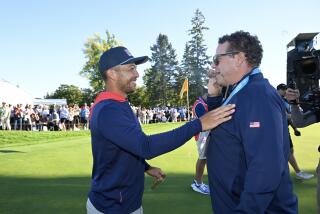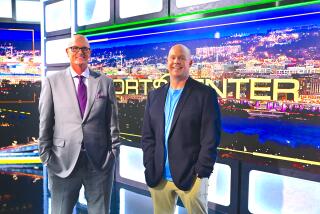ESPN Still Afloat in Uncharted Water : America’s Cup: Network took a chance on sailing’s World Series in 1983 and it paid off.
- Share via
Some sports fans would just as soon watch grass grow, but to ESPN, the America’s Cup is a major event.
ESPN’s public relations department treats it as if it were a Super Bowl or World Series, putting out a binder full of media information.
“It’s a signature event for us,” said Steve Bornstein, ESPN president. “It’s another example of ESPN attempting a project no one else thought possible and turning it into a success story. We did it with the NFL draft, we did it with the NCAA basketball tournament, we did it with shows like ‘NFL PrimeTime’ and ‘Baseball Tonight.’
“This is our hallmark, our calling card. With an increasingly crowded television dial, you need to set yourself apart. You need to provide compelling, unique programming. The America’s Cup does that.”
ESPN discovered the America’s Cup in September of 1983.
Viewers called to let ESPN, then a 4-year-old fledgling cable network, know that off the shores of Newport, R.I., not too far from its headquarters in Bristol, Conn., was a sporting event it might consider covering.
At the time, Dennis Conner’s Liberty was sailing against John Bertrand’s Australia II, and Bertrand was about to do the unthinkable--take the America’s Cup away from America.
With the series tied, 3-3, going into the final race on Monday, Sept. 26, ESPN made a last-minute deal to share a feed from a Providence television station. The coverage consisted of a camera in a helicopter tracking what essentially were two tiny dots in the Atlantic Ocean.
It was Stone Age television, but to ESPN’s surprise, the coverage averaged a 2.4 rating, a weekday afternoon record, and peaked at 4.6.
Those who tuned in saw Australia win the Cup, ending the New York Yacht Club’s 132-year hold on it.
When the United States got a chance to win it back in January of 1987, ESPN was there, even though it meant transmitting signals from Fremantle, Australia.
That was not only costly, it also meant, because of the time difference between Australia and the United States, that races were on in the middle of the night on the East Coast, ending around 3 a.m.
Even so, ESPN paid $650,000 for the U.S. rights to the 1987 America’s Cup. Although the organizing committee supplied the pictures, ESPN spent another $500,000 to transmit the signals via satellite.
Counting other costs, such as facilities, travel and room and board for its crew, the cable network ended up with a tab of around $2 million.
But with 10 blue-chip advertisers, attracted to the event because of yachting’s upscale audience, ESPN made a profit.
“The America’s Cup was a major building block for this network,” said Chris LaPlaca, ESPN vice president of communications. “Two months later, we signed our first NFL deal.”
ESPN’s current NFL contract carries a price tag of $450 million for four years.
The network paid $3 million for the rights to this year’s America’s Cup.
The San Diego event, which started with preliminary races in January and concludes with the best-of-seven final, beginning Saturday, is getting twice as much coverage as the Fremantle competition.
The biggest improvement in coverage between 1983 and ’87 was the result of on-board cameras.
“The on-board camera was a big step in Australia,” said Jed Drake, ESPN’s coordinating producer. “Now those techniques have been refined and improved with better equipment.”
The big steps this year are on-board microphones and sophisticated graphics that keep viewers better informed about each boat’s speed and position.
An animated graphics display tracking system, known as SailTrack and developed by Silicon Graphics and Trimble Navigation, allows ESPN to explain and illustrate details ranging from changing wind conditions to analysis of the finer points of racing.
As with the Olympics and other international events, the organizers provide a world feed, with ESPN and other carriers supplying their own commentary, graphics, features and music.
Because of a cash shortage, the America’s Cup Organizing Committee (ACOC) in January had to give control of the TV rights to a group of eight foreign syndicates, known as the Challenger of Record Committee (CORC).
That really had no effect on the telecasts, though, because the same company, Trans World International, remained in charge of producing the world feed.
All the fancy coverage in the world wouldn’t have done much good during the defender finals had Conner and Stars & Stripes been eliminated by Bill Koch and Kanza during the semifinals.
For a while, it appeared as if it was going to be Koch vs. Koch in finals--his America 3squaring off against Kanza. That would have been about as exciting as watching a Dodger intrasquad game.
Koch’s America 3 ended up beating Conner’s Stars & Stripes, 7-4, to advance to the final against Italy’s Il Moro di Venezia.
ABC will televise Race 1 Saturday. Then ESPN takes over for the remaining races, with live coverage beginning at noon each race day until there is a winner. Monday, Wednesday, Friday and the following Monday are days off.
ABC announcers Frank Gifford and Jack Whitaker will join the ESPN crew of Jim Kelly, Gary Jobson and Peter Isler for Race 1 of the finals.
Kelly came to ESPN in 1985 after 12 years with CBS radio.
Jobson, a world-class sailor and author of 10 books, was tactician for Ted Turner aboard Courageous during the 1977 America’s Cup and briefly worked for Koch in 1990.
Isler was the navigator of Stars and Stripes in 1987.
More to Read
Go beyond the scoreboard
Get the latest on L.A.'s teams in the daily Sports Report newsletter.
You may occasionally receive promotional content from the Los Angeles Times.










